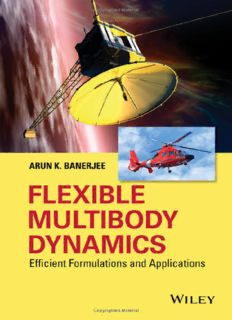Table Of ContentFLEXIBLE MULTIBODY
DYNAMICS
EFFICIENT FORMULATIONS
AND APPLICATIONS
ArunK. Banerjee
FormerlyPrincipalResearchScientist
LockheedMartinAdvancedTechnologyCenter
PaloAlto,CA
USA
Thiseditionfirstpublished2016©2016JohnWiley&SonsLtd
Registeredoffice
JohnWiley&SonsLtd,TheAtrium,SouthernGate,Chichester,WestSussex,PO198SQ,UnitedKingdom
Fordetailsofourglobaleditorialoffices,forcustomerservicesandforinformationabouthowtoapplyfor
permissiontoreusethecopyrightmaterialinthisbookpleaseseeourwebsiteatwww.wiley.com.
TherightoftheauthortobeidentifiedastheauthorofthisworkhasbeenassertedinaccordancewiththeCopyright,
DesignsandPatentsAct1988.
Allrightsreserved.Nopartofthispublicationmaybereproduced,storedinaretrievalsystem,ortransmitted,inany
formorbyanymeans,electronic,mechanical,photocopying,recordingorotherwise,exceptaspermittedbytheUK
Copyright,DesignsandPatentsAct1988,withoutthepriorpermissionofthepublisher.
Wileyalsopublishesitsbooksinavarietyofelectronicformats.Somecontentthatappearsinprintmaynotbe
availableinelectronicbooks.
Designationsusedbycompaniestodistinguishtheirproductsareoftenclaimedastrademarks.Allbrandnamesand
productnamesusedinthisbookaretradenames,servicemarks,trademarksorregisteredtrademarksoftheir
respectiveowners.Thepublisherisnotassociatedwithanyproductorvendormentionedinthisbook.
LimitofLiability/DisclaimerofWarranty:Whilethepublisherandauthorhaveusedtheirbesteffortsinpreparing
thisbook,theymakenorepresentationsorwarrantieswithrespecttotheaccuracyorcompletenessofthecontentsof
thisbookandspecificallydisclaimanyimpliedwarrantiesofmerchantabilityorfitnessforaparticularpurpose.Itis
soldontheunderstandingthatthepublisherisnotengagedinrenderingprofessionalservicesandneitherthe
publishernortheauthorshallbeliablefordamagesarisingherefrom.Ifprofessionaladviceorotherexpert
assistanceisrequired,theservicesofacompetentprofessionalshouldbesought.
LibraryofCongressCataloging-in-PublicationData
Banerjee,ArunK.,author.
Flexiblemultibodydynamics:efficientformulationsandapplications/ArunK.Banerjee.
pagescm
Includesbibliographicalreferencesandindex.
ISBN978-1-119-01564-2(hardback)
1.Machinery,Dynamicsof. 2.Multibodysystems–Mathematicalmodels. I.Title.
TJ173.B2352015
621.8′11–dc23
2015033623
AcataloguerecordforthisbookisavailablefromtheBritishLibrary.
Coverimages:Redrescuehelicoptermovinginbluesky:©aragami123345/iStock;Roboticprobeindeepspace,
computerillustration:VictorHabbickVisions/SciencePhotoLibrary/Getty
Setin10/12ptTimesbyAptaraInc.,NewDelhi,India
1 2016
Thisbookisdedicatedto:
Alpona,mywifewhosufferedoverthirty-five yearsasIworkedatmy
jobandonweekendsandnightsforpublications,andurgedmetowrite
thisbookafterIretired,butdidnotlivetoseeitpublished;
and
ProfessorThomasKane,mymentor, fromwhosemagnificentbooksI
learnedtododynamics, andwhostartedmeonthepathtopublished
researchthatthisbookembodies;
and
Ourdaughter, Onureena,andson, Abheek,whohavebeenmyblessings;
and
LockheedMartinSpaceSystemsCompany anditsmanagers,
particularlyDr.RonDotson,whogavemeafreehandtoworkonthe
algorithms reportedhere,whichledtoaflexiblemultibodydynamicscode
developedwithmajorhelpfrommycolleague,MarkLemak,andseveral
independentformulations.
Contents
Preface ix
1 DerivationofEquationsofMotion 1
1.1 AvailableAnalyticalMethodsandtheReasonforChoosingKane’sMethod 1
1.2 Kane’sMethodofDerivingEquationsofMotion 2
1.2.1 Kane’sEquations 4
1.2.2 SimpleExample:EquationsforaDoublePendulum 4
1.2.3 EquationsforaSpinningSpacecraftwithThreeRotors,FuelSlosh,
andNutationDamper 6
1.3 ComparisontoDerivationofEquationsofMotionbyLagrange’sMethod 11
1.3.1 Lagrange’sEquationsinQuasi-Coordinates 14
Reader’sExercise 15
1.4 Kane’sMethodofDirectDerivationofLinearizedDynamicalEquation 16
1.5 PrematurelyLinearizedEquationsandaPosterioriCorrectionbyadhoc
AdditionofGeometricStiffnessduetoInertiaLoads 19
1.6 Kane’sEquationswithUndeterminedMultipliersforConstrainedMotion 21
1.7 SummaryoftheEquationsofMotionwithUndeterminedMultipliers
forConstraints 22
1.8 ASimpleApplication 23
Appendix1.A GuidelinesforChoosingEfficientMotionVariablesin
Kane’sMethod 25
ProblemSet1 27
References 28
2 Deployment,Station-Keeping,andRetrievalofaFlexibleTether
ConnectingaSatellitetotheShuttle 29
2.1 EquationsofMotionofaTetheredSatelliteDeploymentfromthe
SpaceShuttle 30
2.1.1 KinematicalEquations 31
2.1.2 DynamicalEquations 32
2.1.3 SimulationResults 35
2.2 Thruster-AugmentedRetrievalofaTetheredSatellitetotheOrbitingShuttle 37
2.2.1 DynamicalEquations 37
Contents v
2.2.2 SimulationResults 47
2.2.3 Conclusion 47
2.3 DynamicsandControlofStation-KeepingoftheShuttle-TetheredSatellite 47
Appendix2.A SlidingImpactofaNoseCapwithaPackageofParachute
UsedforRecoveryofaBoosterLaunchingSatellites 49
Appendix2.B FormationFlyingwithMultipleTetheredSatellites 53
Appendix2.C OrbitBoostingofTetheredSatelliteSystemsby
ElectrodynamicForces 55
ProblemSet2 60
References 60
3 Kane’sMethodofLinearizationAppliedtotheDynamicsofaBeamin
LargeOverallMotion 63
3.1 NonlinearBeamKinematicswithNeutralAxisStretch,Shear,andTorsion 63
3.2 NonlinearPartialVelocitiesandPartialAngularVelocitiesfor
CorrectLinearization 69
3.3 UseofKane’sMethodforDirectDerivationofLinearized
DynamicalEquations 70
3.4 SimulationResultsforaSpace-BasedRoboticManipulator 76
3.5 ErroneousResultsObtainedUsingVibrationModesinConventionalAnalysis 78
ProblemSet3 79
References 82
4 DynamicsofaPlateinLargeOverallMotion 83
4.1 MotivatingResultsofaSimulation 83
4.2 ApplicationofKane’sMethodologyforProperLinearization 85
4.3 SimulationAlgorithm 90
4.4 Conclusion 92
Appendix4.A SpecializedModalIntegrals 93
ProblemSet4 94
References 96
5 DynamicsofanArbitraryFlexibleBodyinLargeOverallMotion 97
5.1 DynamicalEquationswiththeUseofVibrationModes 98
5.2 CompensatingforPrematureLinearizationbyGeometricStiffnessdueto
InertiaLoads 100
5.2.1 RigidBodyKinematicalEquations 104
5.3 SummaryoftheAlgorithm 105
5.4 CrucialTestandValidationoftheTheoryinApplication 106
Appendix5.A ModalIntegralsforanArbitraryFlexibleBody 112
ProblemSet5 114
References 114
6 FlexibleMultibodyDynamics:DenseMatrixFormulation 115
6.1 FlexibleBodySysteminaTreeTopology 115
6.2 KinematicsofaJointinaFlexibleMultibodyBodySystem 115
vi Contents
6.3 KinematicsandGeneralizedInertiaForcesforaFlexibleMultibodySystem 116
6.4 KinematicalRecurrenceRelationsPertainingtoaBodyandIts
InboardBody 120
6.5 GeneralizedActiveForcesduetoNominalandMotion-InducedStiffness 121
6.6 TreatmentofPrescribedMotionandInternalForces 126
6.7 “RuthlessLinearization”forVerySlowlyMovingArticulating
FlexibleStructures 126
6.8 SimulationResults 127
ProblemSet6 129
References 131
7 ComponentModeSelectionandModelReduction:AReview 133
7.1 Craig-BamptonComponentModesforConstrainedFlexibleBodies 133
7.2 ComponentModesbyGuyanReduction 136
7.3 ModalEffectiveMass 137
7.4 ComponentModelReductionbyFrequencyFiltering 138
7.5 CompensationforErrorsduetoModelReductionbyModal
TruncationVectors 138
7.6 RoleofModalTruncationVectorsinResponseAnalysis 141
7.7 ComponentModeSynthesistoFormSystemModes 143
7.8 FlexibleBodyModelReductionbySingularValueDecompositionof
ProjectedSystemModes 145
7.9 DerivingDampingCoefficientofComponentsfromDesired
SystemDamping 147
ProblemSet7 148
Appendix7.A MatlabCodesforStructuralDynamics 149
7.10 Conclusion 159
References 159
8 Block-DiagonalFormulationforaFlexibleMultibodySystem 161
8.1 Example:RoleofGeometricStiffnessduetoInterbodyLoadonaComponent 161
8.2 MultibodySystemwithRigidandFlexibleComponents 164
8.3 RecurrenceRelationsforKinematics 165
8.4 ConstructionoftheDynamicalEquationsinaBlock-DiagonalForm 168
8.5 SummaryoftheBlock-DiagonalAlgorithmforaTreeConfiguration 174
8.5.1 FirstForwardPass 174
8.5.2 BackwardPass 174
8.5.3 SecondForwardPass 175
8.6 NumericalResultsDemonstratingComputationalEfficiency 175
8.7 ModificationoftheBlock-DiagonalFormulationtoHandle
MotionConstraints 176
8.8 ValidationofFormulationwithGroundTestResults 182
8.9 Conclusion 186
Appendix8.A AnAlternativeDerivationofGeometricStiffnessdueto
InertiaLoads 187
Contents vii
ProblemSet8 188
References 189
9 EfficientVariables,RecursiveFormulation,andMulti-PointConstraints
inFlexibleMultibodyDynamics 191
9.1 SingleFlexibleBodyEquationsinEfficientVariables 191
9.2 MultibodyHingeKinematicsforEfficientGeneralizedSpeeds 196
9.3 RecursiveAlgorithmforFlexibleMultibodyDynamicswithMultiple
StructuralLoops 201
9.3.1 BackwardPass 201
9.3.2 ForwardPass 207
9.4 ExplicitSolutionofDynamicalEquationsUsingMotionConstraints 209
9.5 ComputationalResultsandSimulationEfficiencyforMoving
Multi-LoopStructures 210
9.5.1 SimulationResults 210
Acknowledgment 215
Appendix9.A Pseudo-CodeforConstrainednb-Bodym-LoopRecursive
AlgorithminEfficientVariables 216
ProblemSet9 220
References 220
10 EfficientModelingofBeamswithLargeDeflectionandLarge
BaseMotion 223
10.1 DiscreteModelingforLargeDeflectionofBeams 223
10.2 MotionandLoadsAnalysisbytheOrder-nFormulation 226
10.3 NumericalIntegrationbytheNewmarkMethod 230
10.4 NonlinearElastodynamicsviatheFiniteElementMethod 231
10.5 ComparisonoftheOrder-nFormulationwiththeFiniteElementMethod 233
10.6 Conclusion 237
Acknowledgment 238
ProblemSet10 238
References 238
11 Variable-nOrder-nFormulationforDeploymentandRetractionof
BeamsandCableswithLargeDeflection 239
11.1 BeamDiscretization 239
11.2 Deployment/RetractionfromaRotatingBase 240
11.2.1 InitializationStep 240
11.2.2 ForwardPass 240
11.2.3 BackwardPass 243
11.2.4 ForwardPass 244
11.2.5 Deployment/RetractionStep 244
11.3 NumericalSimulationofDeploymentandRetraction 246
11.4 DeploymentofaCablefromaShiptoaManeuveringUnderwater
SearchVehicle 247
viii Contents
11.4.1 CableDiscretizationandVariable-nOrder-nAlgorithmfor
ConstrainedSystemswithControlledEndBody 248
11.4.2 HydrodynamicForcesontheUnderwaterCable 254
11.4.3 NonlinearHolonomicConstraint,Control-ConstraintCoupling,
ConstraintStabilization,andCableTension 255
11.5 SimulationResults 257
ProblemSet11 261
References 267
12 Order-nEquationsofFlexibleRocketDynamics 269
12.1 Introduction 269
12.2 Kane’sEquationforaVariableMassFlexibleBody 269
12.3 MatrixFormoftheEquationsforVariableMassFlexibleBodyDynamics 274
12.4 Order-nAlgorithmforaFlexibleRocketwithCommandedGimbaled
NozzleMotion 275
12.5 NumericalSimulationofPlanarMotionofaFlexibleRocket 278
12.6 Conclusion 285
Acknowledgment 285
Appendix12.A SummaryAlgorithmforFindingTwoGimbalAngle
TorquesfortheNozzle 285
ProblemSet12 286
References 286
AppendixA EfficientGeneralizedSpeedsforaSingleFree-FlyingFlexibleBody 287
AppendixB AFORTRANCodeoftheOrder-nAlgorithm:Applicationto
anExample 291
Index 301
Preface
Thisbookisbasedonmypublishedresearchonderivingcomputationallyefficientequations
of motion of multibody systems with rotating, flexible components. It reflects my work of
over thirty-five years done mostly at Lockheed Missiles & Space Company, and also at
MartinMariettaandNorthropCorporations.Thecoverofthebookdepictstwoexamplesof
flexiblemultibodysystems:theGalileospacecraft,whichwassenttoJupiter,withitsrotating
antennadishonaninertially-fixedbasewithadeployedtruss,andahelicopterinflight.Other
examplesofmultibodysystems,apartfromthehumanbodyitself,areroboticmanipulators,
a space shuttle deploying a tethered subsatellite, and a ship reeling out a cable to a vehicle
doing sea floor mine searches. Formulation of equations of motion is the first step in their
simulation-baseddesign.
Inthisbook,IchoosetouseKane’smethodofderivingequationsofmotion,fortworeasons:
efficiencyinreducinglaborofderivingtheequations,andsimplicityofthefinalequationsdue
to a choice of variables that the method allows. However, the contribution of the book goes
beyondadirectformulationofKane’sequationstomorecomputationallyefficientalgorithms
like block-diagonal and order-n formulations. Another major contribution of this book is in
compensatingforerrorsofprematurelinearization,inherentwiththeuseofvibrationmodes
inlargeoverallmotionproblems,byusinggeometricstiffnessduetoinertialoads.
Ahighlightofthisbookistheapplicationofthetheorytocomplexproblems.InChapter1,
I explain Kane’s method, first with a simple example and then by applying it to a realistic
problem of the dynamics of a three-axis controlled spacecraft with fuel slosh. Presented
separately are Kane’s method of direct linearization of equation of motion and a method
of a posteriori compensation for premature linearization by adding geometric stiffness due
to inertia loads; in the Appendix, a guideline for choosing variables that simplify equations
of motion is provided. In Chapter 2, Kane’s method is used to derive nonlinear dynamical
equations for tethered satellite deployment, station-keeping and retrieval, and a problem of
impact dynamics of a nose cap during ejection of a parachute for recovery of a booster
launchingasatellite.Thenexttwochapterscoverlargeoverallmotionofbeamsandplatesthat
illustratetheapplicationofKane’smethodofdirectlinearization.Chapter5givesaderivation
ofequationsoflargeoverallmotionofanarbitraryflexiblebody,withamethodofredeeming
prematurely linearized equations by adding motion-induced geometric stiffness. Chapter 6
incorporatesthemotion-inducedgeometricstiffnessintothedynamicsofasystemofflexible
bodies in large overall motions. Chapter 7 is a review material from structural dynamics,
based mainly on the book by Craig, with some additional work on mode selection done at
Lockheed. Chapter 8 produces an algorithm for dynamical equations, with block-diagonal
Description:Arun K. Banerjee is one of the foremost experts in the world on the subject of flexible multibody dynamics. This book describes how to build mathermatical models of multibody systems with elastic components. Examples of such systems include the human body itself, construction cranes, cares with trai

